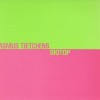Anyway, the gloss is that he’s been doing electronics-only stuff since the ’60s, has links with Tangerine Dream and United Dairies-style Industrial. So that might place him somewhere between floaty and ethereal and concrète désolé. But that’d be disingenuous – a lot of this is more computer game evil carnival than it is Gnostic funerary.
Biotop
First thing to note: The Fall borrowed one of these tracks (“Blutmund”) for “I am Damo Suzuki.” An odd thing to hear that track, one I’ve had in my head for ages, rendered in filthy synth tones and with new queasy harmonies. For the most part Tietchens establishes a rhythm and a melody and colours it with various synth ghostings. There’s a perpetual sense that minor keys can sound a lot more unpleasant when the body of the note is missing a few critical overtones or has some filter/envelope on it that makes the square waves entirely revolting. I’ve not seen any documentation of the gear he’s using, but I’d wager that 1981 was just at a time when synths were available-ish but still heavily modifiable. That is to say, these are either factory presets from someone who had ears tuned wrong or Tietchens has made every effort to make a virtue of electronic gear’s inability to sound like ‘real’ instruments.There’s often a sense with me that earlier electronic music relies upon such an investment from the musician – in terms of labour or how marginal it was – that the musical considerations are quite a lot more to the forefront. There’s a track late on this record – “Trummerkopfe” – which is a sort of bossa with some glacial synths over it and a kind of plonky lead melody. For the most part, the melody is just a synth line, but there’s a bit where the interval jumps a 6th but it’s a 6th and a bit. That’s quite a jarring interval and it’s made more jarring by the fact the note jumps out as being not part of the tonality of the rest. He’s smart, this Tietchens, but not clever-clever. Closing track “Sekundentanz” seems to be closer to a kind of electronic version of spectralism, leaving a droning cluster to reveal its material in intense difference tones over the course of three minutes.
Spät-Europa
Perhaps a fuller sound here – for Biotop there were other personnel but it felt like a single entity. By this point (’82), things are starting to sound like more of a collective thing. More of a spread of textures and tonal qualities, perhaps a bit more on the mixing of instruments and dynamics side of things. Less of a reliance upon drum sounds for rhythmic devices. “Lourdes Extra” has something quite amazing going on with the bass sound, something like a massive plughole but still like an attack than a pluck.I’m not quite sure how to figure it but there’s a bit of a sense that the transition from Biotop to Spät-Europa is one that seemed to bring possibly better gear – while Biotop has the feel of ugly synths being used beyond their crappy limits, Spät-Europa has the feel of something with a bit less pressure in the studio. It’s no less compact and dynamic, but the levels of the synths seems much more varied, diverse. “Bescheidenes Vergnügen” has a descending motif where the source could be a vacuum created by a door closing where, because it’s in a descending scale, it continually creates the impression of slowing down in spite of it not really slowing down. If I’ve got my srsface on, there’s definitely a sense that Spät-Europa feels more like a record with a lot of attention paid to the material. Where Biotop does a great job of sounding vicious, Spät-Europa is a great deal more lugubrious and malicious. “Erloschene Herzen”, perhaps, is the sort of thing that makes me realise that little Stevie Stapleton was only ever part of an admittedly small culture of folk making music for catastrophic lift accidents in windy disused taxidermy factories.
I don’t want to overplay the Industrial thing – while I’ve got a lot of affection for the SPKs and so-forth, I sort of see Tietchens as part of that in a fairly circumspect way. It’s perhaps a fish-or-fowl proposition – he definitely doesn’t fit too closely with even the most electronic of Krautrockers (Cluster maybe?) but he’s not quite brutalist or singular enough to sit with Industrial proper. I mean, the association is definitely there – he did do records on United Dairies – but perhaps it’s more a nominal association than a generic one.Ok, so it is a bit of a shame that I’m talking about 30+ year old records rather than new stuff – and his newer stuff, at least what I heard, is pretty blindingly compelling and dense, perhaps less fettered by the technology he’s using. But of course we don’t get to the present day without this stuff, and this stuff is (yawn) historically important, an important snapshot of a time in synths but it is (yay) also engaging stuff in its own terms – plenty of attention to detail, plenty of variety and plenty of songs that could just as easily be stolen by Mark E Smith again.
Huzzah!
-Kev Nickells-





